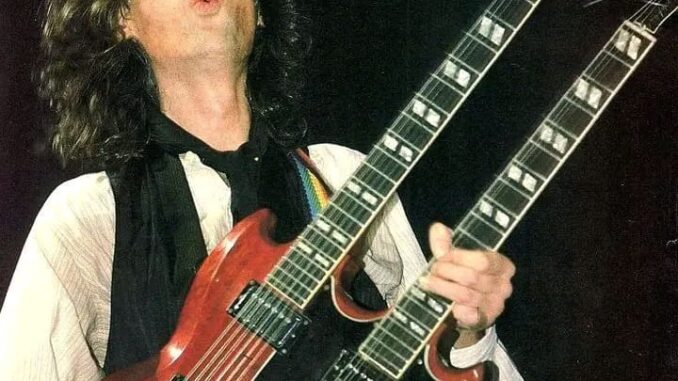
Black Beauty’: The Tale of Jimmy Page’s Stolen Guitar
In April 1970, during Led Zeppelin’s triumphant North American tour, guitarist Jimmy Page pulled out his prized 1960 Gibson Les Paul Custom—darkly nicknamed “Black Beauty”—for a final rendition of “Whole Lotta Love” at the Met Center in Bloomington, Minnesota. Little did he know, it would be the last time he’d see his beloved instrument for decades .
The guitar vanished between the Twin Cities airport and their next destination in Montreal. Page and his camp mounted a desperate search, even placing ads in Rolling Stone magazine offering a reward, but the trail quickly ran cold . For Over 45 years, “Black Beauty” remained missing—likely hidden away under someone’s bed or in a basement storage, its identity obscured but for its serial number .
A chance discovery in St. Paul
Fast forward to 1993: veteran Minnesota vintage-guitar dealer Nate Westgor of Willie’s American Guitars purchased what was rumored to be Page’s Les Paul for a modest $5,000. He sold it to his employee, Paul “Bleem” Claesgens, who played it for more than two decades, believing he held nothing more than a great-sounding instrument with “the voice of God” when strumming .
In 2014, during a routine repair, Westgor placed the guitar under a black light and uncovered telltale signs of Page’s original modifications—drilled holes from added toggle switches that had been covered up . Even more definitive was the distinctive mother‑of‑pearl inlay at the 12th fret: a “lightning bolt” or stripe visible in a 1970 Royal Albert Hall film clip. The match was confirmed .
> “Once I saw those two holes, I was like, ‘Oh my God’ — the hair stood up,” Westgor recalled .
> “When I first met Jimmy over 20 years ago, we went out to lunch and he said to me, ‘I’d like you to find my Les Paul Custom for me,’” said Perry Margouleff, a collector who helped broker the reconnection .
Making things right
Determined to return the guitar honorably, Page’s camp arranged a goodwill swap: Claesgens received a pristine, no-history 1959 Les Paul Custom—valued at around $70,000—while Page got his original “Black Beauty” back in November 2015 . The exchange transpired at a meeting in Dallas organized by Westgor, Margouleff, and Page’s representatives .
Westgor even gifted the guitar its own hotel room on the drive from Minnesota to Texas—“God forbid I step on it,” he joked .
Page was understandably emotional. Westgor described his reaction: “It was an incredible emotional moment… he just couldn’t believe it.” .
Legacy and impact
Following its dramatic return, “Black Beauty” went on public display at the Metropolitan Museum of Art’s “Play It Loud” exhibition in early 2016, cementing its status as a piece of rock history .
Collectors estimate its worth could now be in the multi‑million-dollar range—comparable to other iconic guitars sold at auction . Meanwhile, in 2008, Gibson released a 500‑unit “Artist Reissue” tribute to the original, giving fans a chance to own their very own slice of legend—even before the real thing returned .
Fan reactions and cultural resonance
Fans on Reddit shared in the awe:
> “The history and lore behind that particular guitar is almost unbelievable, except for the fact that it’s all true.”
> “This story surfaced 10 years ago… AFAIK it happened in 2015. The serial numbers matched.”
Closing chords
From its theft at an airport to its rightful return decades later, Jimmy Page’s “Black Beauty” journey reads like a novel—a testament to persistence, passion, and integrity. As Page likely reflects on its restoration—not just to his possible hands again, but into the annals of musical mythology—“Black Beauty” stands as both a symbol of loss and the redemptive power of restoration in rock’s legendary saga.
Leave a Reply